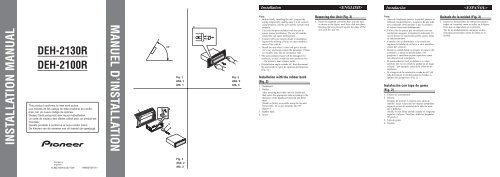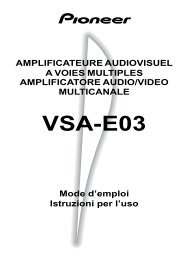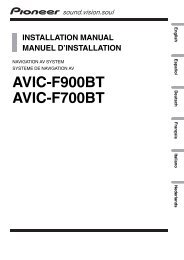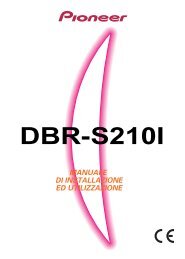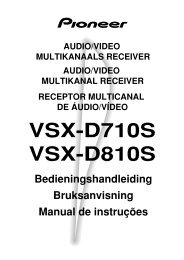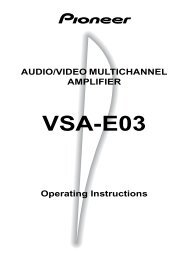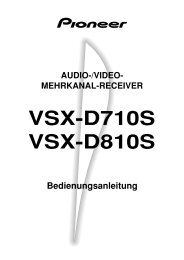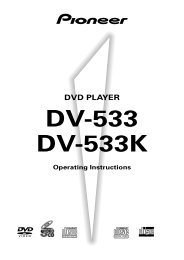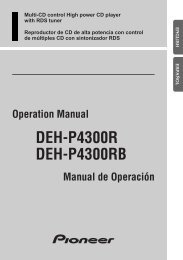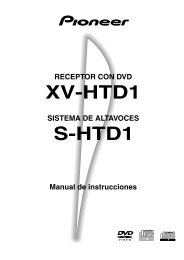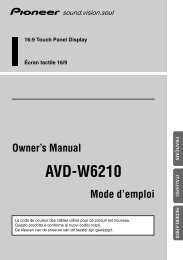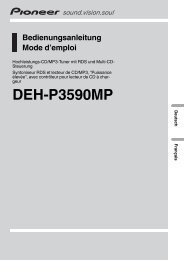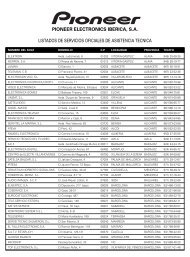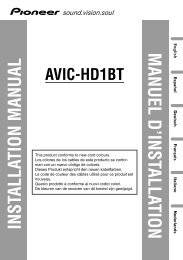installation manual manuel d'installation - Service.pioneer-eur.com
installation manual manuel d'installation - Service.pioneer-eur.com
installation manual manuel d'installation - Service.pioneer-eur.com
You also want an ePaper? Increase the reach of your titles
YUMPU automatically turns print PDFs into web optimized ePapers that Google loves.
Installation<br />
<br />
Instalación<br />
<br />
INSTALLATION MANUAL<br />
DEH-2130R<br />
DEH-2100R<br />
This product conforms to new cord colors.<br />
Los colores de los cables de este producto se conforman<br />
con un nuevo código de colores.<br />
Dieses Gerät entspricht den neuen kabelfarben.<br />
Le code de coul<strong>eur</strong> des câbles utilisé pour ce produit est<br />
nouveau.<br />
Questo prodotto è conforme ai nuovi codici colori.<br />
De kl<strong>eur</strong>en van de snoeren van dit toestel zijn gewijzigd.<br />
MANUEL D’INSTALLATION<br />
1<br />
53<br />
182<br />
60°<br />
2<br />
3<br />
4<br />
Fig. 1<br />
Abb. 1<br />
Afb. 1<br />
5<br />
Fig. 3<br />
Abb. 3<br />
Afb. 3<br />
Note:<br />
• Before finally installing the unit, connect the<br />
wiring temporarily, making sure it is all connected<br />
up properly, and the unit and the system work<br />
properly.<br />
• Use only the parts included with the unit to<br />
ensure proper <strong>installation</strong>. The use of unauthorized<br />
parts can cause malfunctions.<br />
• Consult with your nearest dealer if <strong>installation</strong><br />
requires the drilling of holes or other modifications<br />
of the vehicle.<br />
• Install the unit where it does not get in the driver’s<br />
way and cannot injure the passenger if there<br />
is a sudden stop, like an emergency stop.<br />
• The semiconductor laser will be damaged if it<br />
overheats, so don’t install the unit anywhere hot<br />
— for instance, near a heater outlet.<br />
• If <strong>installation</strong> angle exceeds 60° from horizontal,<br />
the unit might not give its optimum performance.<br />
(Fig. 1)<br />
Installation with the rubber bush<br />
(Fig. 2)<br />
1. Dashboard<br />
2. Holder<br />
After inserting the holder into the dashboard,<br />
then select the appropriate tabs according to the<br />
thickness of the dashboard material and bend<br />
them.<br />
(Install as firmly as possible using the top and<br />
bottom tabs. To secure, bend the tabs 90<br />
degrees.)<br />
3. Rubber bush<br />
4. Screw<br />
Removing the Unit (Fig. 3)<br />
5. Insert the supplied extraction keys into the unit,<br />
as shown in the figure, until they click into place.<br />
Keeping the keys pressed against the sides of the<br />
unit, pull the unit out.<br />
Nota:<br />
• Antes de finalmente instalar la unidad, conecte el<br />
cableado temporalmente y asegúrese de que todo<br />
esté conectado correctamente y que la unidad y<br />
el sistema funcionan debidamente.<br />
• Utilice sólo las piezas que se incluyen con esta<br />
unidad para asegurar la instalación adecuada. El<br />
uso de piezas no autorizadas podría causar fallos<br />
de funcionamiento.<br />
• Consulte con su distribuidor si la instalación<br />
requiere del taladro de orificios u otras modificaciones<br />
del vehículo.<br />
• Instale la unidad donde no alcance el espacio del<br />
conductor, y donde no pueda dañar a los<br />
pasajeros si sucediera un paro repentino, <strong>com</strong>o<br />
una detención de emergencia.<br />
• El semiconductor láser se dañará si se sobrecalienta,<br />
por eso no instale la unidad en un lugar<br />
caliente – por ejemplo, cerca de la salida de un<br />
calefactor.<br />
• Si el ángulo de la instalación excede los 60° del<br />
lado horizontal, la unidad podría no brindar su<br />
óptimo funcionamiento. (Fig. 1)<br />
Instalación con tope de goma<br />
(Fig. 2)<br />
1. Tablero de instrumentos<br />
2. Soporte<br />
Después de insertar el soporte en la tabla de<br />
mandos, luego seleccione las orejetas apropiadas<br />
según el grosor del material de la tabla de mandos<br />
y dóblelos.<br />
(Instale lo más firme posible usando las lengüetas<br />
superior e inferior. Para fijar, doble las lengüetas<br />
90 grados.)<br />
3. Tope de goma<br />
4. Tornillo<br />
Quitado de la unidad (Fig. 3)<br />
5. Inserte las herramientas de extracción suministradas<br />
en la unidad, <strong>com</strong>o se indica en la figura,<br />
hasta que se enganchen en su positión.<br />
Tire de la unidad mientras mantiene las herramientas<br />
presionadas contra los lados de la<br />
unidad.<br />
Printed in<br />
Imprimé<br />
EW<br />
<br />
Fig. 2<br />
Abb. 2<br />
Afb. 2
Einbau<br />
<br />
Installation<br />
<br />
Installazione<br />
<br />
Installeren<br />
<br />
Hinweis:<br />
• Schließen Sie vor dem Einbau die Leitungen<br />
vorübergehend an und stellen Sie sicher, das alles<br />
richtig angeschlossen ist und das Gerät und das<br />
System einwandfrei arbeiten.<br />
• Um einwandfreien Einbau zu gewährleisten, sollten<br />
nur die mit dem Gerät mitgelieferten Teile<br />
verwendet werden. Bei Verwendung von Nicht-<br />
Originalteilen kann es zu Funktionsstörungen<br />
kommen.<br />
• Wenden Sie sich an Ihren Fachhänlder, wenn<br />
zum Einbau des Geräts Löcher gebohrt oder<br />
andere Veränderungen an Ihrem Auto vorgenommen<br />
werden müssen.<br />
• Bauen Sie das Gerät an einer Stelle ein, wo es<br />
den Fahrer nicht behindert und den Beifahrer bei<br />
plötzlichem Bremsen nicht verletzen an.<br />
• Der Halbleiterlaser wird bei Überhitzung<br />
beschädigt, bauen Sie das Gerät daher nicht an<br />
einer Stelle ein, wo es heiß wird, z.B. nahe einer<br />
Heizungsauslaßöffnung.<br />
• Wenn der Einbauwinkel mehr als 60º von der<br />
Horizontalen abweicht, kann es sein, daß das<br />
Gerät nicht optimal arbeitet. (Abb.1)<br />
Einbau mit der Gummibuchse<br />
(Abb. 2)<br />
1. Armaturenbrett<br />
2. Halter<br />
Den Halter in das Armaturenbrett einsetzen, dann<br />
die der Dicke des Armaturenbretts entsprechenden<br />
Zungen auswählen und diese biegen.<br />
(Mit Hilfe der Ansätze, oben und unten, so fest<br />
wie möglich einsetzen. Zur Sicherung werden die<br />
Ansätze 90 Grad gebogen.)<br />
3. Gummibuchse<br />
4. Schraube<br />
Entnahme des Gerätes (Abb. 3)<br />
5. Die mitgelieferten Ausziehschlüssel wie in der<br />
Abbildung gezeigt bis zur Einrastposition in das<br />
Gerät einsetzen. Die Schlüssel gegen die Seiten<br />
des Geräts drücken und das Gerät herausziehen.<br />
Remarque:<br />
• Avant de finaliser l’<strong>installation</strong> de l’appareil,<br />
connecter temporairement le câblage en s’assurant<br />
que tout est correctement connecté et que<br />
l’appareil et le système fonctionnent correctement.<br />
• Pour obtenir une bonne <strong>installation</strong>, n’utiliser que<br />
les pièces de l’appareil. L’utilisation de pièces<br />
non prévues risque de causer un mauvais fonctionnement.<br />
• Consulter le concessionnaire le plus proche si<br />
l’<strong>installation</strong> nécessite le percement de trous ou<br />
toute autre modification du véhicule.<br />
• Installer l’appareil à un endroit où il ne gêne pas<br />
le conduct<strong>eur</strong> et où il ne peut pas blesser les passagers<br />
en cas d’arrêt brusque, <strong>com</strong>me pendant un<br />
arrêt d’urgence.<br />
• Le laser semiconduct<strong>eur</strong> sera endommagé en cas<br />
de réchauffement excessif. Dans ce cas ne pas<br />
installer l’appareil dans un endroit présentant une<br />
température élevée, tel que sortie de chauffage.<br />
• L’angle de l’<strong>installation</strong>, ne doit pas dépasser 60°<br />
par rapport à l’horizontale, faute de quoi l’unité ne<br />
fournira pas ses performances optimales. (Fig. 1)<br />
Installation avec une bague en<br />
caoutchouc (Fig. 2)<br />
1. Tableau de bord<br />
2. Support<br />
Après avoir introduit le support dans le tableau<br />
de bord, sélectíonnez les languettes appropriées<br />
en fonction de l’épaiss<strong>eur</strong> du matériau du tableau<br />
de bord et courbez-les.<br />
(Assurez le maintien aussi solidement que possible<br />
en utilisant les languettes inféri<strong>eur</strong>es et<br />
supéri<strong>eur</strong>es. Cela fait, courbez les languettes de<br />
90 degrés.)<br />
3. Bague en caoutchouc<br />
4. Vis<br />
Dépose de l’únite (Fig. 3)<br />
5. Insérer les clés d’extraction fournis dans l’unité,<br />
<strong>com</strong>me indiqué dans la figure, jusqu’à ce qu’elles<br />
s’enclenchent en position. En maintenant ces clés<br />
pressées contre les côtés de l’unité, retirer l’unité.<br />
Nota:<br />
• Prima di installare definitivamente l’apparecchio,<br />
collegare i fili temporaneamente e accertarsi che<br />
tutti i collegamenti siano corretti e che l’apparecchio<br />
e il sistema funzionino correttamente.<br />
• Per un’installazione appropriata, usare soltanto i<br />
pezzi in dotazione all’apparecchio. L’uso di pezzi<br />
non autorizzati può causare problemi di funzionamento.<br />
• Rivolgersi al più vicino rivenditore se l’installazione<br />
richiede la trapanatura di fori o altre<br />
modifiche del veicolo.<br />
• Installare l’apparecchio in un punto in cui esso<br />
non intralci le manovre del conducente e in cui<br />
non possa provocare lesioni ai passeggeri nel<br />
caso dell’arresto improvviso del veicolo, <strong>com</strong>e<br />
nel caso di una frenata d’emergenza.<br />
• Il laser a semiconduttore subisce danni se si surriscalda;<br />
pertanto, non installare l’apparecchio in<br />
luoghi esposti al calore, <strong>com</strong>e per esempio nei<br />
pressi della bocca di efflusso dell’impianto di<br />
riscaldamento.<br />
• Se l’angolo di installazione supera i 60° rispetto<br />
alla posizione orizzontale, l’apparecchio potrebbe<br />
non fornire prestazioni ottimali. (Fig. 1)<br />
Installazione con la boccola di<br />
gomma (Fig. 2)<br />
1. Cruscotto<br />
2. Supporto<br />
Dopo aver inserito il supporto nel cruscotto,<br />
selezionare le linguette appropriate a seconda<br />
dello spessore del materiale del cruscotto e piegarle.<br />
(Installare quanto più saldamente possibile servendosi<br />
delle linguette superiore e inferiore. Per<br />
fissare, piegare le linguette a 90 gradi.)<br />
3. Boccola di gomma<br />
4. Vite<br />
Estrazione dell’unità (Fig. 3)<br />
5. Inserire le chiavette di estrazione in dotazione<br />
nell’apparecchio, <strong>com</strong>e mostrato nella figura,<br />
finché non scattano in posizione. Tenendo le chiavette<br />
premute contro i lati dell’apparecchio,<br />
estrarre l’apparecchio.<br />
Opmerking:<br />
• Voor u het apparaat definitief installeert, is het<br />
raadzaam eerst alle aansluitingen tijdelijk te<br />
maken om te kontroleren of alles naar behoren<br />
funktioneert, zodat u later niet voor verrassingen<br />
komt te staan.<br />
• Gebruik voor het installeren uitsluitend de bij het<br />
apparaat geleverde onderdelen. Toepassing van<br />
andere dan de goedgek<strong>eur</strong>de onderdelen kan leiden<br />
tot storing in de werking van het apparaat.<br />
• Raadpleeg uw dichtstbijzijnde dealer als het voor<br />
het installeren van het apparaat nodig blijkt gaten<br />
te boren, of andere wijzigingen aan te brengen<br />
aan de auto.<br />
• Installeer het apparaat op een plaats waar het de<br />
bestuurder niet in de weg kan zitten en waar het<br />
ook bij een noodstop e.d. geen gevaar voor de<br />
inzittenden kan opleveren.<br />
• De halfgeleider-laser in het apparaat is gevoelig<br />
voor beschadiging door oververhitting, dus<br />
installeer het apparaat niet te dicht in de buurt<br />
van de autoverwarming of de warme luchtsroom<br />
daarvan.<br />
• Als u het apparaat onder een al te steile hoek<br />
installeert, d.w.z. meer dan 60° uit het horizontale<br />
vlak, zal het niet naar behoren kunnen<br />
werken. (Afb. 1)<br />
Installatie met de rubber mof<br />
(Afb. 2)<br />
1. Dashboard<br />
2. Houder<br />
Nadat u de houder in het dashboard hebt<br />
geplaatst, kiest u de juiste lipjes voor de dikte<br />
van het dashboard-materiaal en buigt u deze om.<br />
(Plaats zo stevig als mogelijk met gebruik van de<br />
boven- en onderlipjes. Buig de lipjes 90 graden<br />
om te vergrendelen.)<br />
3. Rubber mof<br />
4. Schroef<br />
Verwijderen van het apparaat<br />
(Afb. 3)<br />
5. Steek de bijgeleverde verwijdersleutels in het<br />
apparaat, zoals in de afbeelding aangegeven, tot<br />
ze op hun plaats vastklikken. Houd de sleutels<br />
tegen de zijkanten van het apparaat aangedrukt<br />
en trek het apparaat naar buiten.
Connecting the Units<br />
<br />
5.<br />
Note:<br />
Depending on the kind of vehicle, the function<br />
of 3* and 5* may be different. If this is the<br />
case, be sure to connect 2* to 5* and 4* to 3*.<br />
3*<br />
5*<br />
1*<br />
2*<br />
4*<br />
7. Cap (1*)<br />
When not using this terminal,<br />
do not remove the cap.<br />
8. Yellow (3*)<br />
Back-up<br />
(or accessory)<br />
10. Red (5*)<br />
Accessory<br />
(or back-up)<br />
12. Black (ground)<br />
To vehicle (metal) body.<br />
13. ISO connector<br />
Note:<br />
In some vehicles, the ISO connector may<br />
be divided into two. In this case, be sure to<br />
connect to both connectors.<br />
2. Rear output<br />
6. Connect leads of the same<br />
color to each other.<br />
9. Yellow (2*)<br />
To terminal always supplied<br />
with power regardless of ignition<br />
switch position.<br />
11. Red (4*)<br />
To electric terminal controlled<br />
by ignition switch<br />
(12 V DC) ON/OFF.<br />
1. This product<br />
3. Antenna jack<br />
14. Speaker leads<br />
White : Front left +<br />
White/black : Front left ≠<br />
Gray : Front right +<br />
Gray/black : Front right ≠<br />
Green : Rear left +<br />
Green/black : Rear left ≠<br />
Violet : Rear right +<br />
Violet/black : Rear right ≠<br />
17. Fuse resistor<br />
19. Fuse holder<br />
18. Yellow/black<br />
If you use a cellular telephone, connect it via<br />
the Audio Mute lead on the cellular telephone.<br />
If not, keep the Audio Mute lead free of any<br />
connections.<br />
25. Rear speaker<br />
+<br />
22. Blue/white (6*) 23. Blue/white (7*)<br />
To Auto-antenna relay control terminal.<br />
(Max. 300 mA 12 V DC.)<br />
24.<br />
4. Fuse<br />
The pin position of the ISO connector will differ<br />
depends on the type of vehicle. Connect 6* and 7*<br />
when Pin 5 is an antenna control type. In another<br />
type of vehicle, never connect 6* and 7*.<br />
15. Connecting cords with<br />
RCA pin plugs (sold separately)<br />
20. Blue/white<br />
To system control terminal of the power amp.<br />
(Max. 300 mA 12 V DC.)<br />
≠<br />
16. Power amp<br />
(sold separately)<br />
21. System remote control<br />
25. Rear speaker<br />
+<br />
≠<br />
26. Perform these connections when using<br />
a different amp (sold separately).<br />
Note:<br />
• This unit is for vehicles with a 12-volt battery<br />
and negative grounding. Before installing it in a<br />
recreational vehicle, truck, or bus, check the battery<br />
voltage.<br />
• To avoid shorts in the electrical system, be sure<br />
to disconnect the ≠ battery cable before beginning<br />
<strong>installation</strong>.<br />
• Refer to the owner’s <strong>manual</strong> for details on connecting<br />
the power amp and other units, then<br />
make connections correctly.<br />
• Secure the wiring with cable clamps or adhesive<br />
tape. To protect the wiring, wrap adhesive tape<br />
around them where they lie against metal parts.<br />
• Route and secure all wiring so it cannot touch<br />
any moving parts, such as the gear shift, handbrake<br />
and seat rails. Do not route wiring in<br />
places that get hot, such as near the heater outlet.<br />
If the insulation of the wiring melts or gets torn,<br />
there is a danger of the wiring short-circuiting to<br />
the vehicle body.<br />
• Don’t pass the yellow lead through a hole into<br />
the engine <strong>com</strong>partment to connect to the battery.<br />
This will damage the lead insulation and cause a<br />
very dangerous short.<br />
• Do not shorten any leads. If you do, the protection<br />
circuit may fail to work when it should.<br />
• Never feed power to other equipment by cutting<br />
the insulation of the power supply lead of the<br />
unit and tapping into the lead. The current capacity<br />
of the lead will be exceeded, causing overheating.<br />
• When replacing fuse, be sure to use only fuse of<br />
the rating prescribed on this unit.<br />
• Since a unique BPTL circuit is employed, never<br />
wire so the speaker leads are directly grounded<br />
or the left and right ≠ speaker leads are <strong>com</strong>mon.<br />
• Speakers connected to this unit must be highpower<br />
types with minimum rating of 40 W and<br />
impedance of 4 to 8 ohms. Connecting speakers<br />
with output and/or impedance values other than<br />
those noted here may result in the speakers catching<br />
fire, emitting smoke, or be<strong>com</strong>ing damaged.<br />
• When this product’s source is switched ON, a<br />
control signal is output through the blue/white<br />
lead. Connect to an external power amp’s system<br />
remote control or the car’s Auto-antenna relay<br />
control terminal. (Max. 300 mA 12 V DC.) If the<br />
car features a glass antenna, connect to the antenna<br />
booster power supply terminal.<br />
• When an external power amp is being used with<br />
this system, be sure not to connect the blue/white<br />
lead to the amp’s power terminal. Likewise, do<br />
not connect the blue/white lead to the power terminal<br />
of the auto-antenna. Such connection could<br />
cause excessive current drain and malfunction.<br />
• To avoid short-circuiting, cover the disconnected<br />
lead with insulating tape. Especially, insulate the<br />
unused speaker leads without fail. There is a possibility<br />
of short-circuiting if the leads are not<br />
insulated.<br />
• If this unit is installed in a vehicle that does not<br />
have an ACC (accessory) position on the ignition<br />
switch, the red lead of the unit should be connected<br />
to a terminal coupled with ignition switch<br />
ON/OFF operations. If this is not done, the vehicle<br />
battery may be drained when you are away<br />
from the vehicle for several hours.<br />
OFF<br />
ACC<br />
ON<br />
START<br />
ACC position<br />
• The black lead is ground. Please ground this lead<br />
separately from the ground of high-current products<br />
such as power amps.<br />
If you ground the products together and the<br />
ground be<strong>com</strong>es detached, there is a risk of damage<br />
to the products or fire.<br />
• Cords for this product and those for other products<br />
may be different colors even if they have the<br />
same function. When connecting this product to<br />
another product, refer to the supplied Installation<br />
<strong>manual</strong>s of both products and connect cords that<br />
have the same function.<br />
OFF<br />
ON<br />
START<br />
No ACC position<br />
Connection Diagram (Fig. 4)<br />
1. This product<br />
2. Rear output<br />
3. Antenna jack<br />
4. Fuse<br />
5. Note:<br />
Depending on the kind of vehicle, the function of<br />
3* and 5* may be different. If this is the case, be<br />
sure to connect 2* to 5* and 4* to 3*.<br />
6. Connect leads of the same color to each other.<br />
7. Cap (1*)<br />
When not using this terminal, do not remove the<br />
cap.<br />
8. Yellow (3*)<br />
Back-up (or accessory)<br />
9. Yellow (2*)<br />
To terminal always supplied with power regardless<br />
of ignition switch position.<br />
10. Red (5*)<br />
Accessory (or back-up)<br />
11. Red (4*)<br />
To electric terminal controlled by ignition switch<br />
(12 V DC) ON/OFF.<br />
12. Black (ground)<br />
To vehicle (metal) body.<br />
13. ISO connector<br />
Note:<br />
In some vehicles, the ISO connector may be<br />
divided into two. In this case, be sure to connect<br />
to both connectors.<br />
14. Speaker leads<br />
White: Front left +<br />
White/black: Front left ≠<br />
Gray: Front right +<br />
Gray/black: Front right ≠<br />
Green: Rear left +<br />
Green/black: Rear left ≠<br />
Violet: Rear right +<br />
Violet/black: Rear right ≠<br />
15. Connecting cords with RCA pin plugs (sold separately)<br />
16. Power amp (sold separately)<br />
17. Fuse resistor<br />
18. Yellow/black<br />
If you use a cellular telephone, connect it via the<br />
Audio Mute lead on the cellular telephone. If not,<br />
keep the Audio Mute lead free of any connections.<br />
19. Fuse holder<br />
20. Blue/white<br />
To system control terminal of the power amp.<br />
(Max. 300 mA 12 V DC.)<br />
21. System remote control<br />
22. Blue/white (6*)<br />
23. Blue/white (7*)<br />
To Auto-antenna relay control terminal.<br />
(Max. 300 mA 12 V DC.)<br />
24. The pin position of the ISO connector will differ<br />
depends on the type of vehicle. Connect 6* and<br />
7* when Pin 5 is an antenna control type. In<br />
another type of vehicle, never connect 6* and 7*.<br />
25. Rear speaker<br />
26. Perform these connections when using a different<br />
amp (sold separately).<br />
Fig. 4<br />
Abb. 4<br />
Afb. 4
Conexión de las unidades<br />
<br />
5.<br />
Note:<br />
Depending on the kind of vehicle, the function<br />
of 3* and 5* may be different. If this is the<br />
case, be sure to connect 2* to 5* and 4* to 3*.<br />
3*<br />
5*<br />
1*<br />
2*<br />
4*<br />
7. Cap (1*)<br />
When not using this terminal,<br />
do not remove the cap.<br />
8. Yellow (3*)<br />
Back-up<br />
(or accessory)<br />
10. Red (5*)<br />
Accessory<br />
(or back-up)<br />
12. Black (ground)<br />
To vehicle (metal) body.<br />
13. ISO connector<br />
Note:<br />
In some vehicles, the ISO connector may<br />
be divided into two. In this case, be sure to<br />
connect to both connectors.<br />
2. Rear output<br />
6. Connect leads of the same<br />
color to each other.<br />
9. Yellow (2*)<br />
To terminal always supplied<br />
with power regardless of ignition<br />
switch position.<br />
11. Red (4*)<br />
To electric terminal controlled<br />
by ignition switch<br />
(12 V DC) ON/OFF.<br />
1. This product<br />
3. Antenna jack<br />
14. Speaker leads<br />
White : Front left +<br />
White/black : Front left ≠<br />
Gray : Front right +<br />
Gray/black : Front right ≠<br />
Green : Rear left +<br />
Green/black : Rear left ≠<br />
Violet : Rear right +<br />
Violet/black : Rear right ≠<br />
17. Fuse resistor<br />
19. Fuse holder<br />
18. Yellow/black<br />
If you use a cellular telephone, connect it via<br />
the Audio Mute lead on the cellular telephone.<br />
If not, keep the Audio Mute lead free of any<br />
connections.<br />
25. Rear speaker<br />
+<br />
22. Blue/white (6*) 23. Blue/white (7*)<br />
To Auto-antenna relay control terminal.<br />
(Max. 300 mA 12 V DC.)<br />
24.<br />
4. Fuse<br />
The pin position of the ISO connector will differ<br />
depends on the type of vehicle. Connect 6* and 7*<br />
when Pin 5 is an antenna control type. In another<br />
type of vehicle, never connect 6* and 7*.<br />
15. Connecting cords with<br />
RCA pin plugs (sold separately)<br />
20. Blue/white<br />
To system control terminal of the power amp.<br />
(Max. 300 mA 12 V DC.)<br />
≠<br />
16. Power amp<br />
(sold separately)<br />
21. System remote control<br />
25. Rear speaker<br />
+<br />
≠<br />
26. Perform these connections when using<br />
a different amp (sold separately).<br />
Fig. 4<br />
Abb. 4<br />
Afb. 4<br />
Nota:<br />
• Esta unidad es para vehículos con batería de 12<br />
voltios y con conexión a tierra. Antes de instalar<br />
la unidad en un vehículo recreativo, camioneta, o<br />
autobús, revise el voltaje de la batería.<br />
• Para evitar cortocircuitos en el sistema eléctrico,<br />
asegúrese de desconectar el cable de la batería ≠<br />
antes de <strong>com</strong>enzar con la instalación.<br />
• Consulte con el <strong>manual</strong> del usuario para los<br />
detalles sobre la conexión de la alimentación de<br />
amperios y de otras unidades, luego haga las<br />
conexiones correctamente.<br />
• Asegure el cableado con abrazaderas de cables o<br />
con cinta adhesiva. Para proteger el cableado,<br />
envuélvalo con cinta adhesiva donde éstos se<br />
apoyan sobre las piezas de metal.<br />
• Coloque y asegure todo el cableado de tal manera<br />
que no toque las piezas en movimiento, tal<br />
<strong>com</strong>o la palanca de cambio de velocidades, el<br />
freno de mano, y los pasamanos de los asientos.<br />
No coloque el cableado en lugares que se calientan,<br />
tal <strong>com</strong>o cerca de la salida de un calefactor.<br />
Si el material aislante del cableado se derritiera o<br />
se gastara, habrá el peligro de un cortocircuito<br />
del cableado a la carrocería del vehículo.<br />
• No pase el conductor amarillo a través de un orificio<br />
en el <strong>com</strong>partimiento del motor para conectar<br />
a la batería. Esto dañará el material aislante<br />
del conductor y causará un cortocircuito peligroso.<br />
• No acorte ningún conductor. Si lo hiciera, la protección<br />
del circuito podría fallar al funcionar<br />
cuando debería.<br />
• Nunca alimente energía a otros equipos cortando<br />
el aislamiento del conductor de alimentación provista<br />
de la unidad y haciendo un empalme con el<br />
conductor. La capacidad de corriente del conductor<br />
se excederá, causando el recalentamiento.<br />
• Cuando reemplace el fusible, asegúrese de utilizar<br />
solamente un fusible del régimen nominal<br />
prescrito en esta unidad.<br />
• Ya que se emplea un circuito único BPTL, nunca<br />
coloque los cables de manera que los conductores<br />
del altavoz estén directamente en conexión<br />
a tierra o que el altavoz izquierdo y derecho ≠<br />
sean <strong>com</strong>unes.<br />
• Los altavoces conectados a esta unidad deberán<br />
ser del tipo de alta potencia, teniendo un régimen<br />
mínimo de 40 W y una impedancia de 4 a 8<br />
ohmios. La conexión de altavoces con valores de<br />
impedancia y/o de salida diferentes a los anotados<br />
aquí podrían causar fuego, emisión de humo<br />
o daños a los altavoces.<br />
• Cuando se conecta la fuente de este producto,<br />
una señal de control se emite a través del conductor<br />
azul/blanco. Conecte al control remoto de sistema<br />
de un amplificador de potencia externo o al<br />
terminal de controle de relé de antena automática<br />
del vehículo. (Máx. 300 mA 12 V CC.) Si el<br />
vehículo tiene una antena en vidrio, conecte al<br />
terminal de suministro de energía de la antena.<br />
• Cuando se está utilizando un amperio de potencia<br />
externa con este sistema, asegúrese de no conectar<br />
el conductor azul/blanco al terminal de potencia<br />
de amperios. Asimismo, no conecte el conductor<br />
azul/blanco al terminal de potencia de la<br />
auto-antena. Tal conexión podría causar la fuga<br />
de corriente excesiva y causar fallos de funcionamiento.<br />
• Para evitar cortocircuitos, cubra el conductor<br />
desconectado con cinta aislada. Especialmente,<br />
aísle los conductores de altavoz no usados. Hay<br />
la posibilidad de cortocircuito si no se aíslan los<br />
conductores.<br />
• Si se instala esta unidad en un vehículo que no<br />
tiene una posición ACC (accesorio) en el interruptor<br />
de encendido, el conductor rojo de la<br />
unidad deberá conectarse al terminal conectado<br />
con las operaciones del interruptor de encendido<br />
ON/OFF. Si no se hace esto, la batería del<br />
vehículo podría drenarse cuando usted esté lejos<br />
del vehículo por varias horas.<br />
OFF<br />
ACC<br />
ON<br />
START<br />
Posición ACC<br />
• El conductor negro es la masa. Conecte a masa<br />
este conductor separadamente desde la masa de<br />
los productos de alta corriente tal <strong>com</strong>o los<br />
amplificadores de potencia.<br />
Si conecta juntos a masa los productos y la masa<br />
se desconecta, se crea el riesgo de daños a los<br />
productos o de incendios.<br />
• Los cables para esta unidad y aquéllas para las<br />
unidades pueden ser de colores diferentes aun si<br />
tienen la misma función. Cuando se conecta esta<br />
unidad a otra, refiérase a los <strong>manual</strong>es de instalación<br />
de ambas unidades y conecte los cables<br />
que tienen la misma función.<br />
OFF<br />
ON<br />
START<br />
No en la posición ACC<br />
Diagrama de conexión (Fig. 4)<br />
1. Este producto<br />
2. Salida trasera<br />
3. Jack para antena<br />
4. Fusible<br />
5. Nota:<br />
Dependiendo del tipo del vehículo, la función de<br />
3* y 5* puede ser diferente. Si éste es el caso,<br />
asegúrese de conectar 2* a 5* y 4* a 3*.<br />
6. Conecte los conductores del mismo color uno a<br />
otro.<br />
7. Tapa (1*)<br />
Cuando este terminal no se usa, no retire la tapa.<br />
8. Amarillo (3*)<br />
Reserva (o accesorio)<br />
9. Amarillo (2*)<br />
Al terminal con suministro constante de electricidad,<br />
independientemente de la posición del interruptor<br />
de encendido.<br />
10. Rojo (5*)<br />
Accesorio (o reserva)<br />
11. Rojo (4*)<br />
Al terminal de energía eléctrica controlado por el<br />
interruptor de encendido del vehículo (12 V de<br />
CC.) ON/OFF.<br />
12. Negro (masa)<br />
A la carrocería del veículo (parte metálica).<br />
13. Conectro ISO<br />
Nota:<br />
En algunos vehículos, el conector ISO puede<br />
estar dividido en dos partes. Si éste es el caso,<br />
asegúrese de conectar a ambos conectores.<br />
14. Cables de altavoz<br />
Blanco: Izquierdo delantero +<br />
Blanco/negro: Izquierdo delantero ≠<br />
Gris: Derecho delantero +<br />
Gris/negro: Derecho delantero ≠<br />
Verde: Izquierdo trasero +<br />
Verde/negro: Izquierdo trasero ≠<br />
Violeta: Derecho trasero +<br />
Violeta/negro: Derecho trasero ≠<br />
15. Cables de conexión con clavijás RCA (en venta<br />
por separado).<br />
16. Amplificador de potencia (en venta por separado).<br />
17. Resistencia de fusible<br />
18. Amarillo/negro<br />
Si utiliza un teléfono celular, conéctelo por el<br />
cable de enmudecimiento de audio del teléfono<br />
celular. Si no, mantenga el enmudecimiento de<br />
audio liber de cualquier conexión.<br />
19. Portafusible<br />
20. Azul/blanco<br />
Al terminal de control de sistema del amp. de<br />
potencia. (Máx. 300 mA 12 V de CC.)<br />
21. Control remoto de sistema<br />
22. Azul/blanco (6*)<br />
23. Azul/blanco (7*)<br />
Al terminal de control de relé de antena<br />
automática. (Máx. 300 mA 12 V de CC.)<br />
24. La posición de los pinos del conector ISO difiere<br />
de acuerdo al tipo de vehículo. Conecte 6* y 7*<br />
cuando el pino 5 es un tipo de control de antena.<br />
En otros tipos de vehículo, nunca conecte 6* y<br />
7*.<br />
25. Altavoz trasero<br />
26. Lleve a cabo las conexiones cuando utilice un<br />
amplificador diferente (en venta por separado).
Anschließen der Geräte<br />
<br />
Connexion des appareils<br />
<br />
Hinweis:<br />
• Dieses Gerät ist für Fahrzeuge mit 12-V-Batterie<br />
und negativer Erdung (Minuspol an Masse) ausgelegt.<br />
Prüfen Sie vor dem Einbau in ein<br />
Wohnmobil, einen Lastwagen oder Bus die<br />
Batteriespannung.<br />
• Um Kurzschlüsse im elektrischen Systen zu verhindern,<br />
ist unbedingt vor dem Einbau das Minus-<br />
Batteriekabel ≠ abzutrennen.<br />
• Nehmen Sie die Anschlüsse gemäß den<br />
Anweisungen zum Anschluß des<br />
Leistungsverstärkers und anderer Geräte in der<br />
Bedienungsanleitung vor.<br />
• Sichern Sie die Leitungen mit Kabelklemmen oder<br />
Klebeband. Zum Schutz der Leitungen sollten sie<br />
an den Stellen, wo sie Metallteile berühren, mit<br />
Klebeband umwickelt werden.<br />
• Verlegen und sichern Sie alle Leitungen so, daß<br />
sie keine beweglichen Teile wie die<br />
Gangschaltung, die Handbremse und Sitzschienen<br />
berühren. Die Leitungen dürfen nicht an Stellen<br />
entlanggeführt werden, die heiß werden, z.B. an<br />
einer Heizungsauslaßöffnung. Wenn die Isolierung<br />
einer Leitung schmilzt oder aufreißt, besteht die<br />
Gefahr eines Kurzschlusses mit der Karosserie.<br />
• Führen Sie die gelbe Leitung nicht durch ein Loch<br />
in den Motorraum zum Anschluß an die Batterie.<br />
Dadurch wird die Isolierung der Leitung<br />
beschädigt, was zu einem sehr gefährlichen<br />
Kurzschluß führen kann.<br />
• Verkürzen Sie keine Leitungen. In diesem Fall<br />
kann es vorkommen, daß die Schutzschaltung<br />
nicht arbeitet, wenn sie gebraucht wird.<br />
• Führen Sie niemals anderen Geräten Strom zu,<br />
indem Sie die Isolierung der<br />
Stromversorgungsleitung dieses Geräts durchschneiden<br />
und davon Strom abzapfen. Dadurch<br />
wird die Strombelastbarkeit der Leitung überschritten,<br />
was zu Überhitzung führt.<br />
• Als Ersatzsicherungen dürfen nur solche mit dem<br />
vorgeschriebenen Nennwert verwendet werden.<br />
• Da ein einzigartiger BPTL-Schaltkreis verwendet<br />
wird, dürfen die Lautsprecherleitungen niemals<br />
direkt geerdet oder die Minusleitungen ≠ des<br />
rechten und linken Kanals gemeinsam sein.<br />
• Lautsprecher, die an dieses Gerät angeschlossen<br />
werden, müssen eine minimale Nennleistung von<br />
40 W und eine Impedanz zwischen 4 und 8 Ohm<br />
haben. Falls Lautsprecher mit anderen Leistungsund/oder<br />
Impedanzwerten angeschlossen werden,<br />
können die Lautsprecher in Brand geraten, Rauch<br />
entwickeln und beschädigt werden.<br />
• Wenn die Programmquelle dieses Produkts<br />
eingeschaltet wird, wird ein Steuersignal über das<br />
blau/weiße Kabel ausgegeben. An eine System-<br />
Fernbedienung eines externen<br />
Leistungsverstärkers oder an Steckverbinder für<br />
Auto-Antennenrelais-Steuerung des Wagens<br />
anschließen. (Max. 300 mA, 12 V<br />
Gleichspannung.) Wenn der Wagen mit einer<br />
Fensterantenne ausgestattet ist, an die<br />
Antennenverstärker-Stromversorgungsklemme<br />
anschließen.<br />
• Bei Verwendung eines externen<br />
Leistungsverstärkers für dieses System muß die<br />
blau/weiße Leitung an die Leistungsklemme des<br />
Verstärkers angeschlossen werden. Die<br />
blau/weiße Leitung darf nicht an die<br />
Leistungsklemme der Auto-Antenne<br />
angeschlossen werden. Ein solcher Anschluß<br />
könnte übermäßige Stromentnahme und dadurch<br />
Funktionsstörungen verursachen.<br />
• Um einen Kurzschluß zu vermeiden, abgetrennte<br />
Kabel mit Isolierband umwickeln. Unbenutzte<br />
Lautsprecherzuleitungen müssen unbedingt<br />
isoliert werden. Wenn die Kabel nicht isoliert<br />
werden, besteht Kurzschlußgefahr.<br />
• Wenn dieses Gerät in einem Auto eingebaut wird,<br />
das auf dem Zündschalter keine ACC (Zubehör)-<br />
Position hat, sollte die rote Leitung des Geräts an<br />
eine Klemme angeschlossen werden, die mit der<br />
ON/OFF-Operation des Zündschalters gekoppelt<br />
ist. Andernfalls kann die Autobatterie entleert<br />
werden, wenn Sie mehrere Stunden von dem<br />
Fahrzeug weg sind.<br />
OFF<br />
ACC<br />
ON<br />
START<br />
ACC-Position<br />
• Das schwarze Kabel ist das Erdungskabel. Dieses<br />
Kabel ist getrennt von der Erde von Hochstrom-<br />
Geräten, wie z.B. Leistungsverstärkern, zu erden.<br />
Falls die Geräte zusammen geerdet werden, und<br />
die Erdungsstelle abgetrennt wird, besteht die<br />
Gefahr einer Beschädigung der Geräte oder eines<br />
Brands.<br />
• Kabel dieses Geräts und die anderer Geräte können<br />
unterschiedliche Farben haben, auch wenn<br />
sie die gleichen Funktionen haben. Beim<br />
Anschluß dieses Geräts an ein anderes Gerät<br />
unter Bezugnahme auf die mit beiden Geräten<br />
mitgelieferten Installationsanleitungen die Kabel<br />
mit derselben Funktion verbinden.<br />
OFF<br />
ON<br />
START<br />
Keine ACC-Position<br />
Verbindungs-Diagramm (Abb. 4)<br />
1. Dieses Gerät<br />
2. Ausgang für hintere Lautsprecher.<br />
3. Antennenbuchse<br />
4. Sicherung<br />
5. Hinweis:<br />
Je nach Art des Fahrzeugs besitzen 3* und 5*<br />
u.U. unterschiedliche Funktionen. In einem<br />
solchen Fall 2* mit 5* und 4* mit 3* verbinden.<br />
6. Verbinden Sie Leitungen derselben Farbe<br />
miteinander.<br />
7. Kappe (1*)<br />
Wenn dieser Steckverbinder nicht verwendet<br />
wird, die Kappe aufgesetzt lassen.<br />
8. Gelb (3*)<br />
Reserve (oder Zubehör)<br />
9. Gelb (2*)<br />
An eine Stromversorgung anschließen, die unabhängig<br />
vom Zündschloß immer Strom führt.<br />
10. Rot (5*)<br />
Zubehör (oder Reserve)<br />
11. Rot (4*)<br />
An eine Stromversorgung anschließen, (12 V<br />
Gleichstrom), die mit dem Zündschloß ein- und<br />
ausgeschaltet wird.<br />
12. Schwarz (Erdung)<br />
An die Karosserie (Metallteil) anschließen.<br />
13. ISO-Anschluß<br />
Hinweis:<br />
Bei einigen Fahrzeugen kann der ISO-<br />
Steckverbinder in zwei Hälften geteilt sein. In<br />
diesem Fall den Anschluß unbedingt an beiden<br />
Steckverbindern vornehmen.<br />
14. Lautsprecherzuleitungen<br />
Weiß: Vorne links +<br />
Weiß/schwarz: Vorne links ≠<br />
Grau: Vorne rechts +<br />
Grau/schwarz: Vorne rechts ≠<br />
Grün: Hinten links +<br />
Grün/schwarz: Hinten links ≠<br />
Violett: Hinten rechts +<br />
Violett/schwarz: Hinten rechts ≠<br />
15. Verbindungskabel mit RCA-Stiftstecker (getrennt<br />
erhältlich)<br />
16. Leistungsverstärker (getrennt erhältlich)<br />
17. Sicherungswiderstand<br />
18. Gelb/schwarz<br />
Bei Verwendung eines Zellulartelefons dieses<br />
über die Audio Mute-Leitung des Zellulartelefons<br />
anschließen. Andernfalls die Audio Mute-Leitung<br />
frei von Anschlüssen lassen.<br />
19. Sicherungshalter<br />
20. Blau/weiß<br />
An Systemsteuerungs-Steckverbinder der<br />
Endstufe (max. 300 mA, 12 V Gleichspannung).<br />
21. System-Fernbedienung<br />
22. Blau/weiß (6*)<br />
23. Blau/weiß (7*)<br />
An Steckverbinder für Autoantennenrelais-<br />
Steuerung. (Max. 300 mA 12 V Gleichspannung)<br />
24. Die Pin-Position des ISO-Anschlusses hängt vom<br />
Fahrzeugtyp ab. 6* und 7* anschließen, wenn es<br />
sich bei Pin 5 um einen Antennensteuerungstyp<br />
handelt. Bei einem anderen Fahrzeugtyp 6* und<br />
7* niemals anschließen.<br />
25. Hinterer Zusatzlautsprecher<br />
26. Bei Gebrauch eines anderen Verstärkers<br />
(Sonderzubehör) diese Anschlüsse vornehmen.<br />
Remarque:<br />
• Cet appareil est destiné aux véhicules avec une<br />
batterie de 12 V, avec pôle négatif à la masse.<br />
Avant de l’installer dans un véhicule de loisir, un<br />
camion ou un car, vérifier la tension de la batterie.<br />
• Afin d’éviter tout risque de court-circuit,<br />
débrancher le câble de la borne négative ≠ de la<br />
batterie avant de <strong>com</strong>mencer la pose.<br />
• Pour le raccordement des câbles de l’amplificat<strong>eur</strong><br />
de puissance et des autres appareils, se<br />
reporter au <strong>manuel</strong> de l’utilisat<strong>eur</strong> et procéder<br />
<strong>com</strong>me il est indiqué.<br />
• Fixer les câbles au moyen de colliers ou de<br />
morceaux de ruban adhésif. Pour protéger le<br />
câblage, enrouler la bande adhésive autour des<br />
câbles à l’endroit où ceux-ci sont placés contre<br />
les parties métalliques.<br />
• Acheminer et fixer tout le câblage de telle sorte<br />
qu’il ne touche pas les pièces mobiles, <strong>com</strong>me le<br />
levier de changement de vitesse, le frein à main<br />
et les rails des sièges. Ne pas acheminer les<br />
câbles dans des endroits qui peuvent devenir<br />
chauds, <strong>com</strong>me près de la sortie de radiat<strong>eur</strong>. Si<br />
l’isolation des câbles fond ou est se déchire, il<br />
existe un danger de court-circuit des câbles avec<br />
la carrosserie du véhicule.<br />
• Ne pas faire passer le conduct<strong>eur</strong> jaune dans le<br />
<strong>com</strong>partiment mot<strong>eur</strong> par un trou pour le connecter<br />
avec la batterie. Cela pourrait endommager<br />
sa gaine d’isolation et provoquer un grave<br />
court-circuit.<br />
• Ne pas court-circuiter les conduct<strong>eur</strong>s. Dans le<br />
cas contraire, le circuit de protection risque de ne<br />
pas fonctionner.<br />
• Ne jamais alimenter un autre appareil par un<br />
branchement sur le câble d’alimentation de celuici.<br />
Le courant qui circulerait dans ce conduct<strong>eur</strong><br />
pourrait dépasser la capacité du conduct<strong>eur</strong> et<br />
entraîner une élévation anormale de température.<br />
• En cas de remplacement du fusible, n’utilisez<br />
qu’un fusible identique à celui prescrit sur l’appareil.<br />
• Un circuit BPTL unique étant employé, n’effectuez<br />
jamais le câblage de sorte que les fils de<br />
haut-parl<strong>eur</strong>s soient directement mis à la masse<br />
ou que les fils de haut-parl<strong>eur</strong>s ≠ gauche et droit<br />
soient <strong>com</strong>muns.<br />
• Les haut-parl<strong>eur</strong>s connectés à cet appareil<br />
doivent être tels qu’ils puissent supporter une<br />
puissance de 40 W, et que l<strong>eur</strong> impédance soit<br />
<strong>com</strong>prise entre 4 et 8 Ohms. L’utilisation de<br />
haut-parl<strong>eur</strong>s dont la puissance admissible ou<br />
l’impédance seraient différentes des val<strong>eur</strong>s<br />
indiquées ici, pourrait provoquer l<strong>eur</strong> inflammation,<br />
avec émission de fumée, ou à tout le moins<br />
l<strong>eur</strong> endommagement.<br />
• Quand la source de ce produit est positionnée sur<br />
ON, un signal de <strong>com</strong>mande est sorti par le fil<br />
bleu/blanc. Connectez-le à la télé<strong>com</strong>mande<br />
d’ensemble de l’amplificat<strong>eur</strong> de puissance<br />
extéri<strong>eur</strong> ou à la borne de <strong>com</strong>mande du relais<br />
d’antenne motorisée (Max. 300 mA, 12 V CC).<br />
Si la voiture utilise une antenne de vitre,<br />
connectez-le à la prise d’alimentation de<br />
l’amplificat<strong>eur</strong> d’antenne.<br />
• Lorsqu’un amplificat<strong>eur</strong> de puissance externe est<br />
utilisé avec ce système, veiller à ne pas connecter<br />
le fil bleu/blanc à la borne d’alimentation de<br />
l’amplificat<strong>eur</strong>. De la même manière, ne pas connecter<br />
le fil bleu/blanc à la borne d’alimentation<br />
de l’antenne automatique. Un tel branchement<br />
pourrait causer une perte de courant excessive et<br />
un mauvais fonctionnement de l’appareil.<br />
• Pour éviter les courts-circuits, recouvrez les fils<br />
déconnectés par du ruban isolant. En particulier,<br />
n’oubliez pas d’isoler les fils d’enceintes. Un<br />
court-circuit peut se produire si les fils ne sont<br />
pas isolés.<br />
• Si cette unité est installée dans un véhicule dont<br />
le contact<strong>eur</strong> d’allumage n’a pas de position<br />
ACC (accessoire), le fil rouge de l’unité doit être<br />
connecté à une borne couplée aux opérations de<br />
marche/arrêt du contact<strong>eur</strong> d’allumage. Sinon, la<br />
batterie du véhicule peut se décharger lorsque le<br />
véhicule n’est pas utilisé pendant plusi<strong>eur</strong>s<br />
h<strong>eur</strong>es.<br />
OFF<br />
ACC<br />
ON<br />
START<br />
Position ACC<br />
• Le conduct<strong>eur</strong> noir est le câble de masse. Veillez<br />
à relier ce conduct<strong>eur</strong> à une masse qui ne soit pas<br />
la masse d’un appareil gros consommat<strong>eur</strong> d’énergie<br />
tel qu’un amplificat<strong>eur</strong> de puissance.<br />
En effet, si vous utilisez la même masse pour<br />
plusi<strong>eur</strong>s appareils et si ces masses sont<br />
supprimées par un défaut de contact,<br />
l’endommagement de l’appareil, voire un<br />
incendie sont possibles.<br />
• Les câbles de cet appareil et ceux d’autres<br />
appareils peuvent fort bien ne pas être de la<br />
même coul<strong>eur</strong> bien que remplissant la même<br />
fonction. Pour relier cet appareil à un autre<br />
appareil, utilisez le <strong>manuel</strong> d’<strong>installation</strong> de chacun<br />
et effectuez les raccordements en ne tenant<br />
<strong>com</strong>pte que de la fonction de chaque câble.<br />
OFF<br />
ON<br />
START<br />
Aucune position ACC<br />
Schéma de connexion (Fig. 4)<br />
1. Cet appareil<br />
2. Sortie arrière<br />
3. Jack d’antenne<br />
4. Fusible<br />
5. Remarque:<br />
Selon le véhicule, le rôle de 3* et 5* peut être<br />
différent. En ce cas, veillez à relier 2* à 5* et 4*<br />
à 3*.<br />
6. Reliez ensemble les conduct<strong>eur</strong>s de même<br />
coul<strong>eur</strong>.<br />
7. Capuchon (1*)<br />
Si vous n’utilisez pas ce connect<strong>eur</strong>, ne retirez<br />
pas le capuchon.<br />
8. Jaune (3*)<br />
Secours (ou accessoire)<br />
9. Jaune (2*)<br />
Vers une borne alimentée en permanence<br />
indépendamment de la clé de contact.<br />
10. Rouge (5*)<br />
Accessoire (ou secours)<br />
11. Rouge (4*)<br />
Vers une borne dont l’alimentation est <strong>com</strong>mandée<br />
par la clé de contact (12 V CC).<br />
12. Noir (masse)<br />
Fil de masse vers un élément en métal apparent<br />
de la voiture.<br />
13. Connect<strong>eur</strong> ISO<br />
Remarque:<br />
Sur certains véhicules, le connect<strong>eur</strong> ISO peut<br />
<strong>com</strong>porter deux parties. En ce cas, veillez à relier<br />
ces deux parties.<br />
14. Câbles de liaison aux haut-parl<strong>eur</strong>s<br />
Blanc: Avant gauche +<br />
Blanc/noir: Avant gauche ≠<br />
Gris: Avant droite +<br />
Gris/noir: Avant droite ≠<br />
Vert: Arrière gauche +<br />
Vert/noir: Arrière gauche ≠<br />
Violet: Arrière droite +<br />
Violet/noir: Arrière droite ≠<br />
15. Câbles de liaison munis de prises RCA (vendu<br />
séparément).<br />
16. Amplificat<strong>eur</strong> de puissance (vendu séparément)<br />
17. Résistance fusible<br />
18. Jaune/noir<br />
Si vous utillisez un téléphone cellulaire, connectez-le<br />
câble mise en sourdine audio sur la<br />
téléphone cellulaire. Sinon, laisser le câble de<br />
mise en sourdine audio sans aucune connexion.<br />
19. Porte-fusible<br />
20. Bleu/blanc<br />
Vers la borne de <strong>com</strong>mande de l’amplificat<strong>eur</strong> de<br />
puissance (max. 300 mA, 12 V CC).<br />
21. Télé<strong>com</strong>mande d’ensemble<br />
22. Bleu/blanc (6*)<br />
23. Bleu/blanc (7*)<br />
Vers la borne de <strong>com</strong>mande du relais d’antenne<br />
motorisée. (Max. 300 mA 12 V CC)<br />
24. La disposition des broches du connect<strong>eur</strong> ISO<br />
diffère en fonction du type de véhicule.<br />
Connectez 6* et 7* quand la broche 5 est la <strong>com</strong>mande<br />
d’antenne. Sinon, ne connectez jamais les<br />
broches 6* et 7*.<br />
25. Haut-parl<strong>eur</strong> arrière<br />
26. Réalisez ces connexions si vous utilisez un<br />
amplificat<strong>eur</strong> différent (vendu séparément).
Collegamento degli apparecchio<br />
<br />
Aansluiten van de apparatuur<br />
<br />
Nota:<br />
• Questo apparecchio è per veicoli con una batteria<br />
da 12 volt e una messa a massa negativa. Prima<br />
di installarlo in un veicolo sportivo, in un autocarro<br />
o in un autobus, controllare la tensione<br />
della batteria.<br />
• Per evitare cortocircuiti nell”impianto elettrico,<br />
accertarsi di scollegare il cavo della batteria ≠<br />
prima di iniziare l’installazione.<br />
• Fare riferimento al <strong>manual</strong>e di istruzioni per i<br />
dettagli sul collegamento dell’amplificatore di<br />
potenza e di altri apparecchi, quindi eseguire i<br />
collegamenti correttamente.<br />
• Fissare i fili con dei fermacavi o del nastro adesivo.<br />
Per proteggere i fili, avvolgervi attorno del<br />
nastro adesivo nei punti in cui essi sono a contatto<br />
con parti metalliche.<br />
• Disporre e fissare tutti i fili in modo tale che essi<br />
non tocchino alcuna parte in movimento, <strong>com</strong>e<br />
l’asta del cambio, il freno a mano e le guide dei<br />
sedili. Non disporre i fili in luoghi esposti al<br />
calore, <strong>com</strong>e nei pressi della bocca di efflusso<br />
dell’impianto di riscaldamento. Se la guaina<br />
isolante dei fili si fonde o si lacera, c’è il pericolo<br />
che i fili possano provocare cortocircuiti alla carrozzeria<br />
del veicolo.<br />
• Non far passare il cavo giallo attraverso un foro<br />
per inserirlo nel vano motore per collegare la batteria.<br />
Questo danneggia la guaina isolante del<br />
cavo e può causare un cortocircuito molto pericoloso.<br />
• Non accorciare i cavi. Se si accorciano i cavi, il<br />
circuito di protezione potrebbe non funzionare<br />
quando invece dovrebe.<br />
• Non fornire mai alimentazione ad un altro<br />
apparecchio tagliando la guaina isolante del cavo<br />
di alimentazione dell’apparecchio e collegando il<br />
cavo. La capacità di corrente del cavo sarà superata<br />
causando surriscaldamento.<br />
• Quando bisogna sostituire il fusibile, utilizzare<br />
solo un fusibile di valore specificato per questa<br />
unità.<br />
• Poiché è impiegato un unico circuito BPTL, non<br />
eseguire mai i collegamenti in modo tale che i fili<br />
degli altoparlanti siano messi a massa direttamente<br />
o in modo tale che i fili degli altoparlanti<br />
sinistro e destro ≠ siano in <strong>com</strong>une.<br />
• I diffusori collegati a quest’unità devono essere<br />
di alta potenza da almeno 40 W e da 4 a 8 ohm.<br />
Se si usano diffusori con uscita e/o ingresso inferiori,<br />
questi possono prendere fuoco, emettere<br />
fumo o venir danneggiati in altro modo.<br />
• Attivando la sorgente di questo apparecchio,<br />
attraverso il cavo blu/bianco viene emesso un<br />
segnale di <strong>com</strong>ando. Collegare questo cavo al<br />
dispositivo di <strong>com</strong>ando a distanza di un sistema<br />
di amplificatore di potenza esterno, o al terminale<br />
di <strong>com</strong>ando del relais dell’antenna ad alzo automatico<br />
(massimo 300 mA, con corrente continua<br />
a 12 V). Se l’automobile dispone di una antenna<br />
a vetro, collegare il cavo al terminale di alimentazione<br />
del booster dell’antenna.<br />
• Quando si usa un amplificatore di potenza esterno<br />
con questo sistema, accertarsi di non collegare il<br />
cavo blu/bianco al terminale di alimentazione<br />
dell’amplificatore. Allo stesso modo, non collegare<br />
il cavo blu/bianco al terminale di alimentazione<br />
dell’antenna automatica. Tale collegamento<br />
potrebbe causare un consumo di corrente<br />
eccessivo e provocare problemi di funzionamento.<br />
• Per evitare corti circuiti, coprire con nastro isolante<br />
il cavo staccato. In particolare, devono assolutamente<br />
essere ricoperti con nastro isolante i cavi non<br />
usati degli altoparlanti. Se i cavi non vengono isolati<br />
possono verificarsi dei pericolosi corti circuiti.<br />
• Se questo apparecchio viene installato in un veicolo<br />
che non possiede una posizione ACC (accessoria)<br />
sull’interruttore di accensione, il cavo rosso dell’apparecchio<br />
deve essere collegato ad un terminale<br />
accoppiato con le operazioni di accensione/spegnimento<br />
dell’interruttore di accensione. Se ciò non<br />
viene fatto, la batteria del veicolo può scaricarsi<br />
quando si lascia il veicolo per alcune ore.<br />
OFF<br />
ACC<br />
ON<br />
START<br />
Posizione ACC presente Posizione ACC assente<br />
• Il cavo nero è quello di messa a terra. Mettere a<br />
terra questo cavo separatamente da quello di messa<br />
a terra di apparecchi funzionanti con corrente a<br />
tensioni elevate, quali gli amplificatori di potenza.<br />
Se gli apparecchi si trovano messi a terra insieme,<br />
in caso di distacco della messa a terra, possono<br />
verificarsi incendi, o prodursi danni agli<br />
apparecchi.<br />
• I cavi per questo apparecchio e quelli per altri<br />
apparecchi possono avere colori diversi, pur<br />
svolgendo la stessa funzione. Per il collegamento<br />
di questo apparecchio ad un’altro, vedere i<br />
<strong>manual</strong>i di installazione di entrambi gli apparecchi,<br />
e provvedere al collegamento dei cavi aventi<br />
la stessa funzione.<br />
OFF<br />
ON<br />
START<br />
Schema di collegamento (Fig.4)<br />
1. Questo apparecchio<br />
2. Uscita posteriore<br />
3. Terminal per antenna<br />
4. Fusibile<br />
5. Nota:<br />
A seconda del tipo di veicolo, la funzione di 3* e<br />
5* potrebbe essere differente. In tal caso collegare<br />
sempre 2* a 5* e 4* a 3*.<br />
6. Collegare fra loro cavi di uguale colore.<br />
7. Cappuccio (1*)<br />
Se questo terminale non è in uso, non togliere il<br />
cappuccio.<br />
8. Giallo (3*)<br />
Riserva (o accessoria)<br />
9. Giallo (2*)<br />
Al terminale constantemente alimentato, qualunque<br />
sia la posizione della chiave d’accensione.<br />
10. Rosso (5*)<br />
Accessoria (o riserva)<br />
11. Rosso (4*)<br />
Collegare alla chiave d’avviamento ON/OFF. (12<br />
V di c.c.)<br />
12. Nero (massa)<br />
Al telaio (parte metallica) dell’automobile.<br />
13. Connettore ISO<br />
Nota:<br />
In alcuni veicoli, il connettore ISO potrebbe<br />
essere diviso in due. In tal caso, non mancare di<br />
connettere ambedue i connettori.<br />
14. Cavi diffusore<br />
Bianco: Anteriore sinistro +<br />
Bianco/nero: Anteriore sinistro ≠<br />
Grigio: Anteriore destro +<br />
Grigio/nero: Anteriore destro ≠<br />
Verde: Posteriore sinistro +<br />
Verde/nero: Posteriore sinistro ≠<br />
Violetto: Posteriore destro +<br />
Violetto/nero: Posteriore destro ≠<br />
15. Cavi di collegamento con spine a terminale RCA<br />
(venduto separatamente).<br />
16. Amplificatore (venduto separatamente)<br />
17. Resistenza fusibile<br />
18. Giallo/nero<br />
Se si usa un telefono cellegarlo tramite il cavo di<br />
silenziamento audio sul telefono cellulare. In<br />
caso contrario, non collegare affatto il cavo<br />
selinziamento audio.<br />
19. Portafusibili<br />
20. Blu/bianco<br />
Al terminale di controllo del sistema dell’amplificatore<br />
di potenza (massimo 300 mA, con corrente<br />
continua a 12 V).<br />
21. Comando a distanza del sistema<br />
22. Blu/bianco (6*)<br />
23. Blu/bianco (7*)<br />
Al terminale di controllo del relè dell’antenna ad<br />
alzo automatico. (Max. 300 mA, 12 V di c.c.)<br />
24. La posizione dei poli del connettore ISO differisce<br />
in relazione al tipo di veicolo. Se il polo 5<br />
è del tipo per il <strong>com</strong>ando dell’antenna, collegare<br />
6* e 7*. Nei veicoli di altri tipi non collegare mai<br />
6* e 7*.<br />
25. Diffusore posteriore<br />
26. Eseguire questi collegamenti nel caso in cui si<br />
faccia uso di un diverso amplificatore (venduto<br />
separatamente).<br />
Opmerking:<br />
• Dit apparaat is bestemd voor inbouw in voertuigen<br />
met een negatief geaarde 12-volts accu.<br />
Alvorens u het installeert in een auto, bus,<br />
vrachtwagen of ander voer- of vaartuig, dient u<br />
eerst te kontroleren of de accuspanning de juiste<br />
is.<br />
• Om kortsluiting te vermijden, dient u vooral voor<br />
het installeren de negatieve ≠ accukabel los te<br />
maken.<br />
• Zie voor het aansluiten van de eindversterker en<br />
andere apparatuur de gebruiksaanwijzing en volg<br />
de aanwijzingen nauwgezet op.<br />
• Houd de bedrading op zijn plaats met kabelklemmen<br />
of met isolatieband. Wikkel ter bescherming<br />
ook isolatieband om de bedrading waar deze de<br />
metalen oppervlakken van de auto raakt.<br />
• Leid de bedrading altijd zo dat deze niet in aanraking<br />
kan komen met bewegende onderdelen<br />
zoals de versnellingspook, de handrem en de<br />
geleiderails van de stoelen. Zet de bedrading stevig<br />
vast en vermijd ook plaatsen die warm worden,<br />
zoals bij een uitblaasopening van de<br />
autoverwarming. Als de isolatie smelt of door<br />
beweging doorslijt, zou er kortsluiting kunnen<br />
onstaan.<br />
• Leid de gele draad niet door het brandschot naar<br />
de motorruimte voor aansluiting op de accu.<br />
Hierbij is de kans groot op beschadiging van de<br />
isolatie en zeer gevaarlijke kortsluiting.<br />
• Maak de bedrading niet korter. Bij inkorten van<br />
de bedrading kan het beveiligingscircuit niet in<br />
werking treden wanneer dat nodig is.<br />
• Tap geen stroom af van de bedrading door een<br />
stukje isolatie te verwijderen en een andere draad<br />
aan de kerndraad te verbinden. Hierdoor kan de<br />
maximale stroomcapaciteit van de draad overschreden<br />
worden, met als gevolg oververhitting.<br />
• Gebruik voor het vervangen van de zekering uitsluitend<br />
een zekering van het op dit toestel<br />
gespecificeerde vermogen.<br />
• Aangezien er gebruik is gemaakt van een uniek<br />
BPTL circuit, mag u de luidsprekersnoeren nooit<br />
rechtstreeks met de aarde verbinden en mag u<br />
ook niet de negatieve ≠ luidsprekerdraden<br />
gemeenschappelijk aansluiten.<br />
• Sluit op dit apparaat luidsprekers aan die een hoog<br />
ingangsvermogen kunnen verwerken, van nominaal<br />
tenminste 40 W, met een impedantie van 4 tot<br />
8 Ohm. Sluit u luidsprekers aan die niet aan deze<br />
eisen voldoen, dan bestaat er de kans dat de luidsprekers<br />
in brand vliegen, beginnen te roken of<br />
anderszins beschadigd raken.<br />
• Wanneer de signaalbron van dit product aan<br />
(ON) staat, wordt er een controlesignaal geproduceerd<br />
via de blauw/witte draad. Sluit deze aan<br />
op een systeem-afstandsbediening van een<br />
externe power versterker, of op de auto-antenne<br />
relais bedieningsaansluiting van de auto zelf.<br />
(Max. 300 mA 12 Volt gelijkstroom) Als de auto<br />
voorzien is van een glas-antenne, dient u de<br />
aansluiting te maken op de aansluiting van de<br />
stroomvoorziening van de antennebooster.<br />
• Als u met dit apparaat een externe eindversterker<br />
gebruikt, let dan op dat u niet de blauw/witte<br />
draad aansluit op de stroomvoorzieningsaansluiting<br />
van de eindversterker. Sluit de blauw/witte<br />
draad ook niet aan op de stroomaansluiting van<br />
de auto-antenne. Een dergelijke aansluiting kan<br />
een te grote stroomafname en daarmee storing<br />
veroorzaken.<br />
• Om kortsluiting te voorkomen dient u de losgekoppelde<br />
draad af te dekken met isolatieband.<br />
Vergeet vooral niet de ongebruikte luidsprekerdraden<br />
te isoleren. Als de draden niet geïsoleerd<br />
zijn, bestaat er het gevaar van kortsluiting.<br />
• Bij inbouw van dit apparaat in een auto waarvan<br />
het kontaktslot geen “ACC” stand heeft, dient u<br />
de rode stroomdraad van dit apparaat aan te<br />
sluiten op een aansluitpunt waarvan de stroom<br />
wordt in- en uitgeschakeld door ON/OFF zetten<br />
van het kontaktsleuteltje. Als u deze stroomdraad<br />
aansluit op een punt dat altijd stroom krijgt, kan<br />
de accu leegraken als u de auto enkele uren ongebruikt<br />
laat.<br />
OFF<br />
ACC<br />
ON<br />
START<br />
ACC stand<br />
• De zwarte draad is de aardedraad. Aard deze draad<br />
gescheiden van de aarde van toestellen met een<br />
hoog vermogen, bijvoorbeeld eindversterkers.<br />
De toestellen zouden namelijk mogelijk worden<br />
beschadigd of er worde brand veroorzaakt indien<br />
u dit toestel tezamen met andere toestellen aardt<br />
en de aarde wordt ontkoppeld.<br />
• Snoeren voor dit toestel en overeenkomende<br />
snoeren voor andere toestellen hebben mogelijk<br />
verschillende kl<strong>eur</strong>en ookal is de functie van de<br />
snoeren hetzelfde. Zie voor het verbinden van dit<br />
toestel met een ander toestel daarom de installatiehandleiding<br />
van beide toestellen en verbind<br />
de snoeren met dezelfde functie met elkaar.<br />
OFF<br />
ON<br />
START<br />
Geen ACC stand<br />
Aansluitschema (Afb. 4)<br />
1. Dit apparaat<br />
2. Uitgang achter<br />
3. Antenne-aansluiting<br />
4. Zekering<br />
5. Opmerking:<br />
De functie van 3* en 5* is mogelijk versc hillend<br />
afhankelijk van het type auto. Indien dit het geval<br />
is moet u 2* met 5* en 4* met 3* verbinden.<br />
6. Verbind de draden van dezelfde kl<strong>eur</strong> met elkaar.<br />
7. Dopje (1*)<br />
Niet verwijderen indien u deze aansluiting niet<br />
gebruikt.<br />
8. Geel (3*)<br />
Ondersteuning (of accessoire)<br />
9. Geel (2*)<br />
Naar de aansluiting die altijd van stroom<br />
voorzien wordt onafhankelijk van de stand van<br />
het contact.<br />
10. Rood (5*)<br />
Accessoire (of ondersteuning)<br />
11. Rood (4*)<br />
Naar de door het contact (12 Volt gelijkstroom)<br />
(ON/OFF) geregelde elektrische aansluiting.<br />
12. Zwart (aarde)<br />
Naar de (metalen) carrosserie van het voertuig.<br />
13. ISO aansluiting<br />
Opmerking:<br />
In bepaalde auto’s is de ISO aansluiting mogelijk<br />
in tweeën verdeeld. U moet in dat geval een<br />
verbinding met beide aansluitingen maken.<br />
14. Luidsprekerdraden<br />
Wit: Linksvoor +<br />
Wit/zwart: Linksvoor ≠<br />
Grijs: Rechtsvoor +<br />
Grijs/zwart: Rechtsvoor ≠<br />
Groen: Linksachter +<br />
Groen/zwart: Linksachter ≠<br />
Paars: Rechtsachter +<br />
Paars/zwart: Rechtsachter ≠<br />
15. Aansluitsnoeren met RCA stekkers (los verkrijgbaar).<br />
16. Eindversterker (los verkrijgbaar)<br />
17. Zekeringlabel<br />
18. Geel/zwart<br />
Gebruikt u een celluaire telefoon, sluit u deze<br />
dan aan via de Audio Mute dempingsaansluiting<br />
voor de cellulaire telefoon. Maakt u daarvan geen<br />
gebruik, laat de Audio Mute dempingsaansluniting<br />
dan vrij, zonder hierop iets aan te sluiten.<br />
19. Zekeringhouder<br />
20. Blauw/wit<br />
Naar de systeembedieningsaansluiting van eindversterker<br />
(max. 300 mA 12 V gelijkstroom).<br />
21. Systeemafstandsbediening<br />
22. Blauw/wit (6*)<br />
23. Blauw/wit (7*)<br />
Naar auto-antenne relaisbedieningsaansluiting.<br />
(max. 300 mA 12 Volt gelijkstroom)<br />
24. De penposities van de ISO stekker kan verschillen<br />
afhankelijk van het soort voortuig. Sluit<br />
6* en 7* aan wanneer Pen 5 van het antennebedieningstype<br />
is. In andersoortige voortuigen<br />
mag u 6* en 7* nooit aansluiten.<br />
25. Achter-luidspreker<br />
26. Maak deze verbindingen wanneer u een andere<br />
versterker (los verkrijgbaar) gebruikt.


